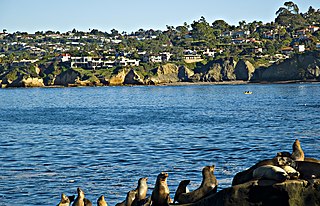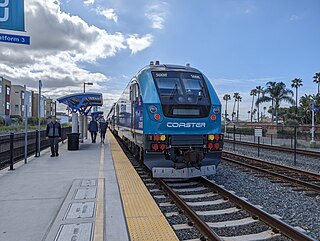
San Diego is a city on the Pacific coast of Southern California, adjacent to the Mexico–United States border. With a population of over 1.3 million residents, it is the eighth-most populous city in the United States and the second-most populous in the state of California, after Los Angeles. San Diego is the seat of San Diego County, which has a population of nearly 3.3 million people. It is known for its mild year-round Mediterranean climate, extensive beaches and parks, long association with the United States Navy, and its recent emergence as a healthcare and biotechnology development center.

Transportation in Boston includes roadway, subway, regional rail, air, and sea options for passenger and freight transit in Boston, Massachusetts. The Massachusetts Port Authority (Massport) operates the Port of Boston, which includes a container shipping facility in South Boston, and Logan International Airport, in East Boston. The Massachusetts Bay Transportation Authority (MBTA) operates bus, subway, short-distance rail, and water ferry passenger services throughout the city and region. Amtrak operates passenger rail service to and from major Northeastern cities, and a major bus terminal at South Station is served by varied intercity bus companies. The city is bisected by major highways I-90 and I-93, the intersection of which has undergone a major renovation, nicknamed the Big Dig.

Transportation in Philadelphia involves the various modes of transport within the city and its required infrastructure. In addition to facilitating intracity travel, Philadelphia's transportation system connects Philadelphia to towns of its metropolitan area and surrounding areas within the Northeast megalopolis.

The San Diego Trolley is a light rail system serving San Diego County, California. The trolley's operator, San Diego Trolley, Inc., is a subsidiary of the San Diego Metropolitan Transit System (MTS). The trolley operates as a critical component of MTS, with connections to and integrated travel tickets with the local bus systems.

The transportation system of New York City is a network of complex infrastructural systems. New York City, being the most populous city in the United States, has a transportation system which includes one of the largest and busiest subway systems in the world; the world's first mechanically ventilated vehicular tunnel; and an aerial tramway. New York City is home to an extensive bus system in each of the five boroughs; citywide and Staten Island ferry systems; and numerous yellow taxis and boro taxis throughout the city. Private cars are less used compared to other cities in the rest of the United States.

People in the San Francisco Bay Area rely on a complex multimodal transportation infrastructure consisting of roads, bridges, highways, rail, tunnels, airports, seaports, and bike and pedestrian paths. The development, maintenance, and operation of these different modes of transportation are overseen by various agencies, including the California Department of Transportation (Caltrans), the Association of Bay Area Governments, San Francisco Municipal Transportation Agency, and the Metropolitan Transportation Commission. These and other organizations collectively manage several interstate highways and state routes, eight passenger rail networks, eight trans-bay bridges, transbay ferry service, local and transbay bus service, three international airports, and an extensive network of roads, tunnels, and bike paths.

The following is a list of transportation options in San Diego County, California.

Oceanside Transit Center is a major railway interchange in Oceanside, California, serving both intercity and suburban/commuter services. The station is used by Amtrak on the route of its Pacific Surfliner service between San Diego and San Luis Obispo. It is also a terminus for two different regional transit operators – Metrolink, the commuter rail operator for the Los Angeles area, has two of its services, the Orange County Line and Inland Empire–Orange County Line, that terminate at Oceanside, while the North County Transit District (NCTD), the operator for most of the public transport in the North County, has its COASTER and SPRINTER services also terminating at Oceanside. Oceanside Transit Center is also served by Greyhound Lines and numerous NCTD BREEZE buses.

Old Town Transit Center, also known as San Diego–Old Town station, or Old Town San Diego station, is an intermodal transportation station in the Old Town neighborhood of San Diego, California. It is served by Amtrak's Pacific Surfliner, the COASTER commuter rail service, and the San Diego Trolley, as well as numerous San Diego Metropolitan Transit System bus lines.

The San Diego Metropolitan Transit System is a public transit service provider for San Diego County, California. The agency operates a transit system that includes the San Diego MTS bus system, San Diego Trolley, and Rapid. MTS also controls the San Diego and Arizona Eastern (SD&AE) freight railway and regulates taxicabs, jitneys, and other private for-hire passenger transportation services.

California's transportation system is complex and dynamic. Although known for its car culture and extensive network of freeways and roads, the state also has a vast array of rail, sea, and air transport. Several subway, light rail, and commuter rail networks are found in many of the state's largest population centers. In addition, with the state's location on the West Coast of the United States, several important ports in California handle freight shipments from the Pacific Rim and beyond. A number of airports are also spread out across the state, ranging from small general aviation airports to large international hubs like Los Angeles International Airport and San Francisco International Airport.

San Diego–Tijuana is an international transborder agglomeration, straddling the border of the adjacent North American coastal cities of San Diego, California, United States, and Tijuana, Baja California, Mexico. The 2020 population of the region was 5,456,577, making it the largest bi-national conurbation shared between the United States and Mexico, and the second-largest shared between the US and another country. The conurbation consists of San Diego County, in the United States and the municipalities of Tijuana, Rosarito Beach (126,980), and Tecate (108,440) in Mexico. It is the third most populous region in the California–Baja California region, smaller only than the metropolitan areas of Greater Los Angeles and the San Francisco Bay Area.

The Blue Line is a 26.3-mile (42.3 km) light rail line in the San Diego Trolley system, operated by San Diego Trolley, Inc., an operating division of the San Diego Metropolitan Transit System (MTS). With an end-to-end travel time of one hour and twenty-three minutes, it operates between UTC Transit Center and San Ysidro Transit Center, the latter of which is at the Mexico–United States border directly adjacent to the San Ysidro Port of Entry, facilitating easy connections across the border. The line serves La Jolla, downtown San Diego, National City, Chula Vista, and San Ysidro and is the system's longest line.

San Ysidro Transit Center is a San Diego Trolley station in the San Ysidro neighborhood of San Diego, California. The station is the southern terminus of the Blue Line and is located on a short rail spur off the San Diego and Arizona Eastern Railway main line which hosts the Blue Line to downtown San Diego.

Chicago, Illinois, is the third-largest city in the United States and a world transit hub. The area is served by two major airports, numerous highways, elevated/subway local train lines, and city/suburban commuter rail lines; it is the national passenger rail hub for Amtrak routes, and also the main freight rail hub of North America.

The Jacksonville transportation network includes ground, air, and sea options for passenger and freight transit. The Jacksonville Port Authority (Jaxport) operates the Port of Jacksonville, which includes container shipping facilities at Blount Island Marine Terminal, the Talleyrand Marine Terminal and the Dames Point Marine Terminal. Jacksonville Aviation Authority managers Jacksonville International Airport in Northside, as well as several smaller airports. The Jacksonville Transportation Authority (JTA) operates bus, people mover, and park-n-ride services throughout the city and region. A major bus terminal at the intermodal Rosa Parks Transit Station serves as JTA's main transit hub. Various intercity bus companies terminate near Central Station. Amtrak operates passenger rail service to and from major cities throughout North America. The city is bisected by major highways, I-95 and I-10, I-295 creates a full beltway around the city.

Rapid is a bus rapid transit system serving San Diego County, California. It is part of the San Diego Metropolitan Transit System (MTS). The system mainly operates on the HOV lanes of Interstate 15 and 805. Freeway-level stations are located in the medians of Interstate 15, Park Boulevard, and East Palomar Street.

Balboa Avenue Transit Center is a San Diego Trolley station in San Diego. The station is located along Balboa Avenue between Interstate 5 and Morena Boulevard. Service began on November 21, 2021 after the completion of the Blue Line Mid-Coast Trolley extension project.

The transportation system of Cleveland is a network that includes several modes of transportation including sidewalks, roads, public transit, bicycle paths and regional and international airports.




















